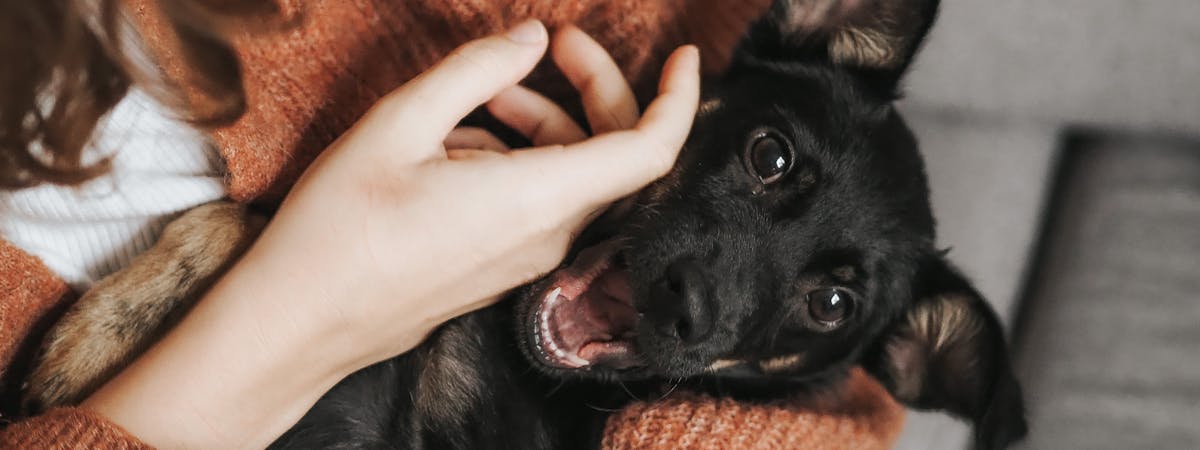Getting a new puppy is likely to be one of the most exciting and memorable moments of your life. Watching that tiny fur ball bound around your house will lead to endless hours of laughter and joy, as the cute mutt gets itself into all sorts of scrapes.
But at the same time, there’s a certain responsibility that comes with owning a puppy. It might be adorable when a puppy leaps all over the sofa and playfully nips at your fingers, but it won’t be so adorable when your doggy friend is a big adult doing the same thing. Or even worse, if your fully grown pup is nipping at strangers in the street. To be a responsible pet owner, you’ll need to train your puppy to obey commands and play nicely with other humans and dogs. But when should you start puppy training? And what does puppy training involve, exactly?
Trending posts
Purr-use some of the top blogs our members have been loving this month- Top male dog names for your new furry friendGot a new furry family member in your pack? Check…

- Top female dog names for your new fluffy palWelcoming a new pooch into your family? Explore…

- 120+ gray cat names your silver feline will loveRecently welcomed a fluffy gray bundle of joy into…

- What are normal pet sitting rates?Discover the average pet sitting rates for animals…

- Unique dog names to stand out from the packDare to be different with our list of the best…

Basic puppy training timeline
Below is an outline of the kinds of things you should be teaching your adorable pooch as he or she grows. It’s not an exact science, and different pet associations may advise slightly different things at different ages, but this should give you a broad overview of puppy training by age. You can also take a look at our beginner’s guide to puppy training for more information.
7-8 Weeks Old
Your puppy will probably be around 7 or 8 weeks old when it arrives in your home, and this irrepressible ball of energy will spend hours happily bounding about your house, exploring all the exciting new things. At this point, the main thing to teach your puppy is to recognise its name. You can reinforce this by giving your puppy a treat when it looks at you after you call its name.
You’ll also want to think about starting toilet training right away. Set up a schedule where you take the puppy to its designated toilet spot at regular points during the day, and give it praise and encouragement after it does its business in the right place.
Otherwise, the main thing is to get your puppy used to being handled by picking it up regularly and giving it lots of affection – which you’ll probably be doing anyway.
8-10 Weeks Old
It's about this time when your puppy will receive its vaccinations – once your pooch has been fully vaccinated, it can begin to socialise with other dogs and explore the outside. Meanwhile, you can get your puppy used to socialisation by introducing it to other people, for example by inviting friends and relatives round to your home. And of course, you should continue with toilet training.
At this young age, you can begin to introduce very basic commands – namely sit, stay and come. Give your puppy lots of praise and affection whenever it obeys a command, and you can use puppy treats to reinforce the training.
You may also want to start crate training. A dog crate is usually a wire cage with bedding at the bottom, and the puppy can use this as a safe space. You’ll also want to get the puppy used to its crate for trips to the vet. Lead the puppy to its crate and leave it alone for short periods to get it used to its safe space and to ease separation anxiety.
10-12 Weeks Old
At around this point you can start to introduce more advanced commands, such as down, heel and place (i.e., go to the spot I’m pointing at and stay there).
If you haven’t done it already, you should also get your puppy used to its lead/leash and harness. You should only take your puppy out for walks after it’s been fully vaccinated, but before that you can put on its harness and get the puppy used to being led around indoors.
Probably the most important thing to do at this age is to control the puppy’s biting. The puppy will begin to explore the world by nipping everything in sight, including ankles and hands. You should head off any inappropriate bites to flesh (or indeed expensive furniture) by diverting the puppy to something more appropriate for biting, like a squeaky toy.
12-16 Weeks Old
This is about the time when you’ll be getting your pup used to socialising with other puppies. Your wee dog should have been vaccinated by this point, so you can take it for play sessions with other vaccinated puppies. This is also when you can start to take your adorable fluff ball to puppy training classes.
3-4 Months Old
Once your puppy has started to master basic training commands, you can begin to introduce command combinations. For example, telling your puppy to sit, come and stay one after the other.
You can also think about introducing further commands, like leave it, as well as reinforcing all the commands the puppy has already learnt.
4-6 Months Old
As your puppy grows older, get it used to obeying commands in new and unfamiliar locations. It can be easy for puppies to get distracted when exploring new places, like the park, so take your pup to unfamiliar environments and get them used to listening to and obeying your commands rather than wandering off in a frenzy of excitement. You’ll also be starting to take your pup for longer walks at this point.
It’s a good idea to wean your puppy off food rewards around now – otherwise your dog will expect a treat for doing anything at all!
6 Months – 1 Year Old
Once your puppy reaches six months, you might want to consider more advanced dog training classes. And as it continues towards adulthood, you’ll need to continually reinforce commands, as well as maintain a daily routine to reduce any feelings of anxiety in your dog.
But, when should you start puppy training classes?
The main thing to consider when deciding when to take your pooch to puppy training classes is vaccinations. Your puppy should have received all of its vaccinations by 12 weeks of age, so that is the ideal time to start puppy training classes.
You should only introduce your pup to other dogs once it is protected from diseases like kennel cough and canine distemper. Many of these vaccinations also require a booster shot several months down the line, but as long as your pup has had the first dose of each vaccination, it should be fine to socialise. Typically, vaccinations are given at between eight and ten weeks of age, although some vets will vaccinate pups as early as four weeks of age.
Generally speaking, it’s best to start puppy training as soon as you’re able to, post-vaccination. Dogs benefit from socialization at a young age, and it’s much easier to teach a dog commands when it’s little.
Tips for keeping your puppy safe in classes
First of all, try to pick a small-sized puppy training class – if there are more than ten puppies together, things can quickly get chaotic. Try to keep happy and relaxed, since if you’re happy, your puppy will be, too. And of course, your pup should be fully vaccinated before it attends classes.
Make sure to give your puppy a toilet break before and after classes, and give them a little bit of light exercise before the class to ensure they’re not too frenetic when instructions begin. You might also want to reduce their food right before the class to ensure they’re responsive to training treats. And give them a rest afterwards – they’ve earned it!
Why should you take your puppy to training classes?
Being a dog owner carries a certain level of responsibility, not only for the wellbeing of your dog, but also for the safety of the people it comes into contact with. In a worst-case scenario, an untrained dog could end up attacking strangers if it gets scared. So training your puppy as soon as you can is essential to ensure it grows up to be a calm and easily controlled dog.
Socialization is incredibly important for young pups, and puppy training classes are a great way to introduce your dog to other puppies and humans. The more socialization a puppy experiences at a young age, the better.
We’re huge pet lovers here at TrustedHousesitters, and we have all sorts of guides to help you look after your new puppy, whether it's things to avoid when leaving your dog alone or how to find a sitter for your dog. And if you want to start pet sitting yourself, you can head this way to find out more information on becoming a TrustedHousesitters member.

